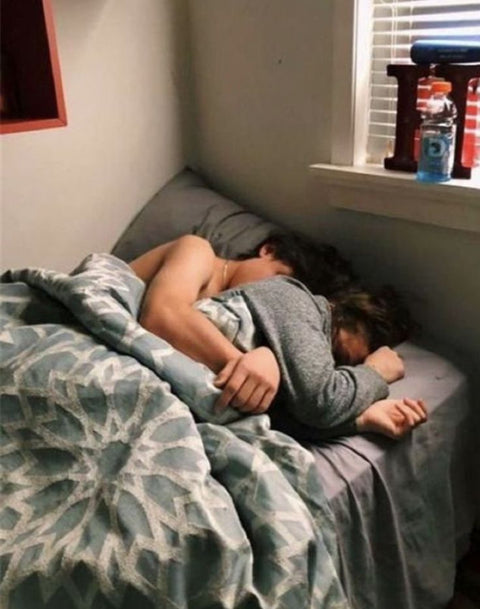
Breakups are tough for everyone, but when you have an anxious attachment style, it can feel completely emotionally overwhelming. You're caught between wanting to move on and the instinctual pull to hold on tighter. Let's explore the rollercoaster of emotions and reactions you might experience if you have an anxious attachment style and find yourself in a breakup.
Understanding Anxious Attachment Style
So, you're the type who craves emotional closeness but can't shake that constant worry about where your relationship is headed? You're likely in the anxious attachment camp. But hey, you're not alone, and anxious is just one way to attach. There are other styles like secure, avoidant, and disorganized that people fall into.
- Secure Attachment: These folks are pretty chill when it comes to relationships. They're confident and handle breakups like a pro, usually with solid coping strategies.
- Avoidant Attachment: These are the lone wolves who act like they don't need anyone. They might seem unfazed by breakups, but that's not always the whole story.
- Disorganized Attachment: These people are a mix of anxious and avoidant, and let's just say breakups can be a rollercoaster for them, triggering all sorts of conflicting feelings.
Knowing you're the anxious type matters big time because it impacts how you view yourself and interact with others, especially in those close relationships. Your attachment style is like your emotional fingerprint—it's unique to you but also has common traits you share with others. This anxious attachment thing isn't random; it usually traces back to your early years and how your caregivers treated you. So, when a breakup happens, it's like a rerun of past abandonments or fears, making the emotional stakes skyrocket.
Understanding your anxious attachment style is like a reality check. It might not be easy to face, but it's the first step toward really understanding why you feel the way you do during a breakup, and how to go about healing in a way that's right for you.
How Do Anxious Attachments React During a Breakup?
So, you've hit that unfortunate bump in the road—a breakup. If you're someone with an anxious attachment style, this is when the emotional rollercoaster kicks into high gear. One minute, you're down in the dumps, feeling like you're unworthy of love. The next, you're high on hope, thinking of strategies to win your ex back. Sound familiar?
The Emotional Rollercoaster: A Breakdown
- Down in the Dumps: Feelings of unworthiness and rejection flood in. Your mind might race with thoughts that you'll never find love again.
- High on Hope: Suddenly, you're brainstorming ways to get back together. You're optimistic, fueled by the tiniest signs of possible reconciliation.
- The Triple-Text Syndrome: Urged by your emotions, you send multiple texts in a row, aiming to reestablish connection but often ending up feeling more anxious.
- Late-Night Call Regret: That late-night call seemed like a good idea at the time, but now you're left second-guessing and feeling vulnerable.
- Rumination Station: Your mind gets stuck in a loop, going over what you could've done differently, analyzing past conversations, and replaying moments.
This emotional whiplash isn't just you being "overdramatic." It's a series of intense emotional peaks and valleys that feel as real as anything. And it's deeply rooted in that anxious attachment style we talked about earlier. You might catch yourself doing things you later regret, like sending that triple-text or making that late-night call. While these actions are fueled by the urge to reestablish connection, they often leave you feeling more disconnected and anxious than before.
The real kicker? All of this emotional chaos can make the healing process way more complicated than it needs to be. Instead of moving on, you might find yourself stuck in a cycle of make-ups and breakups, or continuously ruminating over what you could have done differently. These behaviors don't exactly put you on the fast track to emotional recovery.
But here's some good news: Understanding that your emotional swings are part and parcel of your anxious attachment style can offer you a bit of relief. It means you're not "crazy" or "too much"; you're just programmed to respond this way based on past experiences and deep-seated fears. The first step to smoother sailing is recognizing the rollercoaster for what it is.
Tips for Healing with Anxious Attachment
Okay, so you've recognized the emotional rollercoaster you're on. Now what? Understanding is just the first step; taking action is where the real healing begins. Here's how you can steer your emotional ship toward calmer waters:
Self-Compassion is Key
Cut yourself some slack. You're human, and you're dealing with an attachment style that naturally amplifies your emotional responses. Be kind to yourself. Self-compassion can be a balm for your soul, especially when you start spiraling into self-doubt or regret.
Seek Supportive Relationships
Reach out to friends and family who get you. Supportive relationships can serve as an emotional buffer, reminding you that your self-worth isn't solely tied to romantic relationships.
Set Emotional Boundaries
Know your limits. While it's tempting to seek constant reassurance from others, it's crucial to establish emotional boundaries. This will help you find a healthier balance between intimacy and independence.
Mindfulness and Reflection
Take some time to sit with your thoughts. Try mindfulness techniques to anchor yourself in the present and refrain from catastrophizing the future. Reflect on your relationship patterns and consider what lessons can be learned.
Professional Guidance
Don't underestimate the value of seeking professional help. Therapists can offer coping strategies tailored to your specific needs, helping you navigate the complex emotional landscape that comes with an anxious attachment style.
How to Get Over a Breakup with Anxious Attachment Style
If you've made it through this emotional marathon of an article, you might be wondering, "Okay, but what's next?" That's where our self therapy journal How to Heal an Anxious Attachment Style comes into play. It's not just a journal; it's your emotional toolkit.
Designed specifically to help you tackle anxious attachment and anxiety, the journal is packed with thought-provoking prompts based on the law of detachment and shadow work. Within its pages, you'll discover a space where you can freely explore your emotions, understand the root causes of your anxiety, and build healthy coping mechanisms.

Final Thoughts
If you've made it this far, give yourself a pat on the back. Seriously, understanding your anxious attachment style and how it impacts your reactions to a breakup is no small feat. But knowing is only half the battle. The path to healing may be steep, but it's navigable, and you don't have to walk it alone.
Embrace the journey ahead with self-compassion, set healthy boundaries, and don't hesitate to seek support—whether from loved ones or professionals. You're not defined by your attachment style or past relationships. You're an ever-evolving individual capable of change, growth, and meaningful connections. So take the wheel, steer your emotional ship, and look forward to smoother sailing.



